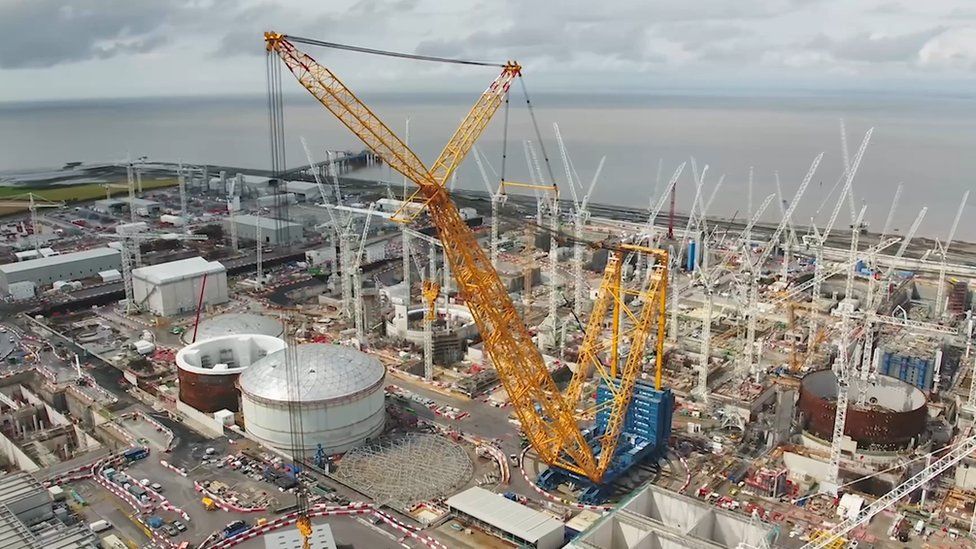Hinkley Point C: Millions of fish under threat after permit change
- Published

The revised operating date for Hinkley Point C is June 2027
Campaigners say tonnes of fish could be sucked into Hinkley Point C's cooling system if an acoustic fish deterrent is not installed.
The Environment Agency (EA) has removed a requirement for EDF to install the deterrent, external, which the company said could be dangerous to maintain.
Environmental groups say millions of fish could be killed per year.
The EA said it was confined to looking at water discharge activity, which did not deal with the entrapment of fish.
A final decision on whether EDF will have to install an acoustic fish deterrent (AFD) will made by the Secretary of State for Environment later this year.
The reactor cooling system tunnels will take in 132,000 litres of water per second from the Severn Estuary to cool the plant's two nuclear reactors.
An AFD would use underwater sound to cause hearing species of fish to swim away.
Marine biologist Dr Paul Naylor said small fish, like herring, sprats and shad will be sucked into the tunnels
But despite a public inquiry in 2021, external requiring EDF to install the acoustic deterrent, the EA has now granted an amendment to the permit, allowing the firm to remove the AFD plans from the development.
Marine biologist Dr Paul Naylor delivered representations to inquiry in 2021, and formerly worked at the Environment Agency on nuclear regulation.
He said: "These cooling tunnels are massive and the amount of fish that will be killed is massive.
"Small and fragile fish, like herring, sprats and shad - which are potential food for seabirds and other fish - will be sucked in and die.
"Imagine if these were air cooling towers and they were sucking in birds and shooting out dead ones - millions of dead birds."
A spokesperson for the Environment Agency said: "Our decision is confined to considering whether an AFD requirement is necessary to protect against polluting effects of the discharge.
"It does not, therefore, deal with entrapment or the impact from entrainment of fish."
EDF said that Hinkley Point C’s water intake system will include a fish recovery and return system and low velocity, side entry water intake heads
Trials of AFD on other nuclear sites in Hartlepool UK and Doel Belgium have shown them to reduce overall fish entrapment into the cooling water system by around 60%, with up to 95% for the more hearing sensitive schooling species, such as sprat and herring.
The Wildfowl and Wetlands Trust (WTT) said the system could be vital to protect the marine biology of the Severn Estuary.
Interim director of conservation, Tim McGrath, added: "The Severn Estuary supports rare and threatened species of fish as well as nurseries where young fish grow and replenish their populations.
"It also hosts an average of over 70,000 wetland birds each winter, including rare fish-eating species.
"Without an effective deterrent in place, or other steps being taken to avoid damage to nature, many more fish will be affected by the development of Hinkley Point C."
The reactor cooling system tunnels are 8m in height and will take in 132,000 litres of water per second
Estimates for the number of fish killed vary drastically - EDF claims that the amount per year would be around 56 tonnes in a year - about the same as would be caught annually by one small fishing vessel.
An EA study concluded that 178 tonnes of fish will be sucked into the pipe per year.
However, an independent panel warned in a report to the Welsh government, external in 2021, that the power station could capture up to 182 million fish per year, and it is likely that many of these will not survive.
EDF argues that the installation and maintenance of the deterrents could be dangerous to divers due to the poor visibility and high tidal range in the Bristol Channel.
The cost of implementing the acoustic deterrent may run into several millions of pounds, and EDF have described the benefits compared to the risks as "negligible".
However, critics state that EDF have failed to take into account the use of remotely operated vehicles during repairs to the AFD, which would negate the risk to human divers.
Estimates for the number of fish that could be affected vary greatly
A spokesperson for EDF said the acoustic deterrent was proposed to work in tandem with other measures, including a low velocity intake pipe - allowing fish to swim away - and a fish recovery and return system inside the pipe.
It said these two measures remain in the plans.
"We are working with Natural England, Natural Resources Wales and the Environment Agency to develop a comprehensive mitigation package to support the removal of an acoustic fish deterrent, which will form part of a full public consultation later this year," EDF said.
Whilst the acoustic fish deterrents have been removed from the current permit, the final decision on implementation falls down to a Development Consent Order which are usually within the remit of the Secretary of State.
Follow BBC West on Facebook, external, Twitter, external and Instagram, external. Send your story ideas to: bristol@bbc.co.uk
Related Topics
- Published20 May 2022
- Published11 April 2023
- Published27 February 2023
- Published27 April 2023